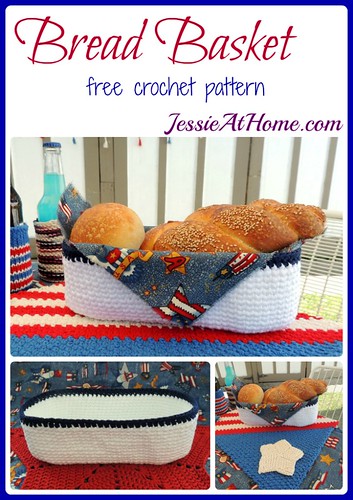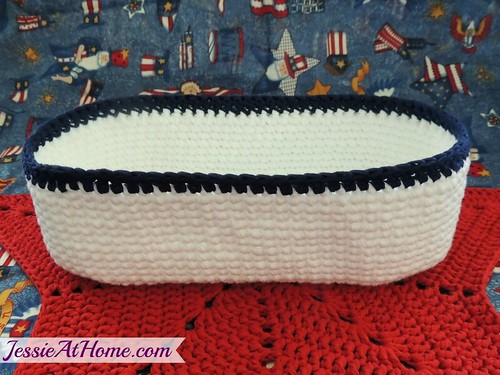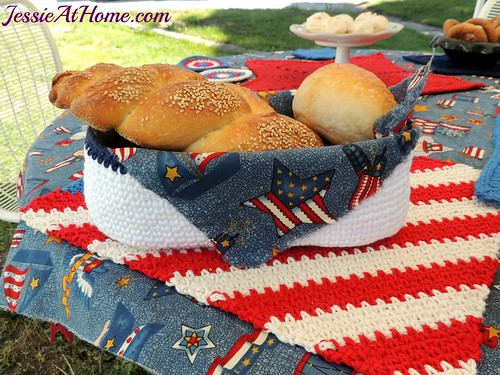This crochet bread basket is a fun way to dress up your everyday dinner rolls, or to show off that pretty braided bread you picked up at the corner deli. Be sure to use a washable yarn that is not too fuzzy so you can clean your bread basket as needed and so it doesn’t leave fuzz in your bread. You can also add a fabric or paper towel liner in your basket and serve chips or various other items out of it. You could even fill it up with wrapped candies!
Bread Basket
Crochet Pattern
Intermediate Skill Level
Designed by Jessie Rayot
This pattern is part of the patriotic party CAL/KAL.
Size:
11.5″ long, 5″ wide, 3.5″ tall
Yarn:
The sample was made with 150g (3 balls) of Tahki Capri, and the final round was made with Tahki Chat. Any bulky yarn that gets the proper gauge with a stiff result will work.
Hook:
US I/9/5.5mm
Gauge:
12.5 sts by 16.5 rows in a 4″ square in ssc. However, close is good enough as this is a bread basket, not a fitted item.
Stitches and Skills used:
ch ~ chain
sl st ~ slip stitch
sc ~ single crochet
st(s) ~ stitch(es)
Special Stitches:
split single crochet (ssc): Insert hook under the top loops AND the loop below the top loops, placing hook in between the 2 “legs” of the stitch. See the top photos below for where the hook is inserted, and the bottom photos to see how the stitch is made:
Getting Started:
The yarn used in this sample has been discontinued, however, some possible substitutions that can be purchased from Amazon have been linked at the bottom of this pattern.
Pattern:
Round 1: Ch 21, 2 sc in back loop of second chain, sc in back loop of next 19 ch, rotate piece, 2 sc in remaining top loop of last ch worked, sc in remaining top loop of next 19 ch, place marker, do not join. ~ 42 sts
Round 2: 2 ssc in each of the next 2 sts, ssc in each of the next 18 st, 2 ssc in each of the next 3 sts, ssc in each of the next 18 st, 2 ssc in the next st, move marker to this point, do not join. ~ 48 sts
Round 3: [2 ssc in next st, ssc in next st] 2 times, ssc in each of the next 18 st, [2 ssc in next st, ssc in next st] 3 times, ssc in each of the next 18 st, 2 ssc in next st, ssc in next st, move marker to this point, do not join. ~ 54 sts
Round 4: [ssc in each of the next 2 sts, 2 ssc in next st] 2 times, ssc in each of the next 18 st, [ssc in each of the next 2 sts, 2 ssc in next st] 3 times, ssc in each of the next 20 st, 2 ssc in next st, move marker to this point, do not join. ~ 60 sts
Round 5: [2 ssc in next st, ssc in each of the next 3 sts] 2 times, ssc in each of the next 18 sts, [2 ssc in next st, ssc in each of the next 3 sts] 3 times, ssc in each of the next 18 st, 2 ssc in next st, ssc in each of the next 3 sts, move marker to this point, do not join. ~ 66 sts
Round 6: [ssc in each of the next 4 sts, 2 ssc in next st] 2 times, ssc in each of the next 18 sts, [ssc in each of the next 4 sts, 2 ssc in next st] 3 times, ssc in each of the next 22 sts, 2 ssc in next st, move marker to this point, do not join. ~ 72 sts
Round 7: [2 ssc in next st, ssc in each of the next 5 sts] 2 times, ssc in each of the next 18 sts, [2 ssc in next st, ssc in each of the next 5 sts] 3 times, ssc in each of the next 18 st, 2 ssc in next st, ssc in each of the next 5 sts, move marker to this point, do not join. ~ 78 sts
Round 8: [ssc in each of the next 6 sts, 2 ssc in next st] 2 times, ssc in each of the next 18 sts, [ssc in each of the next 6 sts, 2 ssc in next st] 3 times, ssc in each of the next 24 sts, 2 ssc in next st, move marker to this point, do not join. ~ 84 sts
Round 9: ssc in each st around, move marker to this point, do not join. ~ 84 sts
Repeat round 9 to desired height.
*Optional: make the last round with a contrasting color to add an accent. You can even cheat here and use a worsted weight yarn for this last round to help keep the top of the basket from flaring out.
Weave in ends and enjoy!
If you enjoy this free crochet pattern, please consider buying some of your supplies from one of these affiliate links. Thank you.
[signature]
















I like all of your patterns.
Thank you!